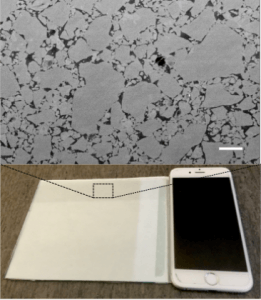Summary
Atomically thin 2D materials constitute promising building blocks for quantum devices due to their exotic, layer-dependent electronic properties. The ability to stack these materials in alternating layers enables heterostructures to be built in almost limitless combinations and over small enough length scales to observe quantum phenomena. So far though, practical implementation of devices based on layered 2D materials has been limited by the challenges of depositing or transferring single atomically thin layers over large areas and of building multi-layers from different materials. In this project, we expand on our previously demonstrated scalable deposition techniques of films for electrochemical applications and control of defects in exfoliated 2D material flakes to build electronic and optoelectronic-based quantum devices in collaboration with Prof. Na Young Kim’s group. Our central goal is to create large area heterostructures of 2D materials built by sequential Langmuir-Blodgett (LB) deposition. We will use these heterostructures to construct simple proof-of-principle quantum devices such as resonant tunneling diodes (RTDs). The work will include finding optimized film parameters for dense, ultrathin tunneling barriers, development of patterning approaches compatible with sequential LB deposition, and ultimately demonstrating a working single, double, and multi-junction RTDs on flexible substrates. While the RTD is one of the simplest quantum devices that can be fabricated from heterostructures of 2D materials, the methodologies we establish in this project will pave the way for improved THz emitters and detectors, faster transistors and memories, and other devices that rely on similar heterostructures and design.
Related Content

Novel Infrared Camera Based on Quantum Sensors for Biomedical Applications
Summary In this project we develop a novel infrared camera with low noise and high detection efficiency for biomedical applications of optical coherence tomography (OCT) using quantum materials. OCT is a technique used to image the back of the eye and allow for the diagnosis of detrimental eye conditions, for e.g., macular degeneration, diabetic retinopathy […]
March 13, 2019

Engineering and Characterizing Programmable Interaction Graphs in a Trapped Ion Quantum Simulator
Summary Quantum simulators have the potential to bring unprecedented capabilities in areas such as the discovery of new materials and drugs. Engineering precise and programmable interaction graphs between qubits or spins forms the backbone of simulator applications. The trapped ion system is unique in that the interaction graph between qubits can be programmed, in […]
July 24, 2018
Folk Understanding of Quantum Physics
Summary It is often said that quantum concepts are counterintuitive. However, quantum concepts may not be equally counterintuitive to people from all cultural backgrounds. As cultural psychologists have discovered, culture fundamentally shapes the way people make sense of the world. In particular, the last few decades of research have documented cultural differences in appreciation of […]
March 24, 2021



